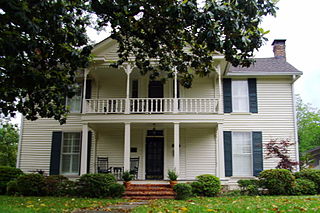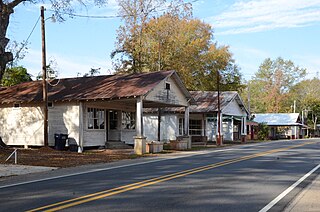
The Main Street Historic District in Fort Atkinson, Wisconsin, United States, was placed on the National Register of Historic Places in 1984. The district is composed of 51 buildings on or within a block of Main Street.

The Great Atlantic and Pacific Tea Company Warehouse is a historic formerly commercial building at 150 Bay Street in Jersey City, Hudson County, New Jersey, United States. Built as a warehouse for The Great Atlantic & Pacific Tea Company (A&P) in 1900, it is the major surviving remnant of a five-building complex of the nation's first major grocery store chain. It was designated a National Historic Landmark in 1978, and now houses a mix of residences and storage facilities.

Moore's Building is a historic building located in the downtown area of the Hamlet of Oyster Bay and listed on the National Register of Historic Places. First built in 1901, the building gained significance when Theodore Roosevelt had his staff take offices here while he served as U.S. President. The Moore's Building is listed on the National Register of Historic Places, a Town of Oyster Bay Landmark, and a featured site on the Oyster Bay History Walk audio walking tour.

The Main Street Historic District in Lake Geneva, Wisconsin is a 2.5-acre (1.0 ha) historic district that was listed on the National Register of Historic Places on January 11, 2002. The listing was amended in some way in a revised listing on March 5, 2002. In 2002, there were 20 buildings in the district that were deemed to contribute to its historic character.

Werthman Grocery is located at a commercial intersection in a residential neighborhood in the West End of Davenport, Iowa, United States. While it initially housed a grocery store, the building has been a long time neighborhood tavern. It was listed on the National Register of Historic Places in 1984.

The Minor Sod House, also known as Minor Post Office, near McDonald, Kansas, is a sod house that was built c. 1907.

Neillsville Downtown Historic District is a section of the historic old downtown of Neillsville, Wisconsin, with buildings as old as 1872. It was added to the National Register of Historic Places in 2000.

The Arkansas City Commercial District encompasses the three oldest surviving commercial buildings in Arkansas City, Arkansas. They are located along Sprague (4th) Avenue, between Kate Adams (1st) Street and De Soto Avenue, and are a reminder of a once-thriving commercial district in the city. The Cotham Drug Store, a two-story brick building from c. 1900, stands near the corner of Sprague and De Soto, facing south. The Red Star Grocery, built 1900, stands to its right; it is also a two-story brick building, but its facade has been altered, replacing a recessed doorway with a flush one. Stylistically the two buildings are similar, with brick corbelling and a course of dentil molding, with a parapet above. The third building is the Ramus Brothers Market, which stands on Sprague Street, and was built in 1910 out of poured concrete.

The Davis-Adams House is a historic house at 509 North Myrtle Street in Warren, Arkansas. It was built c. 1860 in a Plain Traditional style, but received a significant Victorian facelift in the 1890s, when its two-story porch was decorated with spindled balusters and jigsawed details. This work was probably done for its first documented owner, Dr. S.M. Davis, who bought the house in 1888. His daughter, Zena Davis Adams, who married a man with interests in a local grocery store, occupied the house her entire life.

The New Edinburg Commercial Historic District encompasses the historic commercial center of New Edinburg, Arkansas. It includes ten contributing buildings lining Arkansas Highway 8, just north of its junction with Farm Market and Banks Roads. At the time of its listing on the National Register of Historic Places in 2001, all of these buildings, built between c. 1898 and 1940, stood vacant, reflecting the decline of the area.

Harvey's Grocery and Texaco Station is a historic retail establishment at 3241 Arkansas Highway 24, between Camden and Chidester, Arkansas. The single-story concrete block building was built in 1940 by Henry Harvey, replacing a log structure that had previously housed his retail establishment. The building is one of the best-preserved examples of 1940s vernacular general stores and gas stations in the Camden area. The style of the building is, despite its modern construction materials, reminiscent of 19th century retail buildings, with a small windows placed high on the sides, and a full-width front porch. The Harveys pumped gas until 1979, after which the tanks were removed. Harvey's was also a locally notable stop for politicians on the stump in Arkansas: those who are known to have stopped here were Bill Clinton, David Pryor, and Jay Dickey.

The Anderson Brothers Store is a historic general store building at 280 Main Street in Stockholm, Maine, United States. Built in 1901, this 1-1/2 story wood frame structure was the town's first general store, and is its only historic retail building. It operated until the 1950s, and now houses the Stockholm Historical Society's museum.

The Meek Building, also known as the Hogg Building, is a historic commercial building at Main and Oak Streets in Leslie, Arkansas. It is a two-story brick building, with a flat roof obscured by a parapet. Its main entrance is in an angled section at the street corner, with a second store entrance facing Oak Street. Built about 1907, it is one of the oldest commercial buildings in the city, and has long been a local landmark, first housing the grocery of Roy Meek and then the meat shop of G. W. Hogg.

The Saltus Grocery Store is a historic mixed-use commercial and residential building at 299-301 North Winooski Street in Burlington, Vermont. Built in 1897, it is a well-preserved example of a neighborhood store of the period. It was listed on the National Register of Historic Places in 2001.

The Farmer's Union Building in Layton, Utah was listed on the National Register of Historic Places in 1978.

The R.L. Leach Grocery Store is a historic commercial building on Dutch Mills Road in Dutch Mills, Arkansas. Built about 1925, it is a single-story structure with a gabled roof and exterior finished in novelty siding. A shed-roof porch extends across the front facade supported by square posts. The facade is symmetrical, with a pair of entrances, each flanked by sash windows. A parapet above the porch roof is adorned with a sign identifying the building. The building site was where the first general store and post office were located in the village of Dutch Mills, when it was first settled by German immigrants in the 1860s. The present building is in part built in 1925 as a replacement for an earlier store destroyed by fire, and in part from a nearby filling station building, which was grafted onto it. In addition to housing the community store, it also served as its post office until 1968.

The Ross Building is a historic commercial building at 700 South Schiller Street in Little Rock, Arkansas. It is a single-story masonry structure, whose front facade features five bay windows sheltered by awnings, and a high parapet with cornice above. A major extension to the rear is covered by a hip roof, and includes space historically used both by its retail tenants and as residences for owners and employees. The building was built in 1896–97, and originally housed a grocery store serving the area's predominantly German-American population. It has since gone through a significant number of other commercial uses; although its exterior retains many original features, its interior has been heavily modified.

















